
First and Only Weekly Online Fanzine Devoted to the Life and Works of Edgar Rice Burroughs Since 1996 ~ Over 15,000 Webpages and Webzines in Archive |

First and Only Weekly Online Fanzine Devoted to the Life and Works of Edgar Rice Burroughs Since 1996 ~ Over 15,000 Webpages and Webzines in Archive |




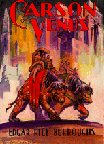
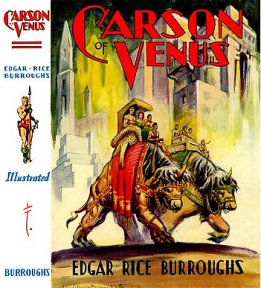
|
|
What would have been plain old Tantor, the elephant, in the Tarzan
Series has here through the magic of ERB’s process of cut and splicing
become a gantor, in fact a pair of them, marching along in tandem with
their howdahs, wearing red and green blankets with a modern city
of skyscrapers in the background. It’s a great idea for a book cover,
and JCB fully reveals his usual great style in illustrating his father’s
strange beast collages.
A gantor, in ERB’s own words, was an “animal larger than an African elephant and had legs very similar to those of that animal, but here the likeness ceased. The head was bull-like and armed with a stout horn about a foot long that grew out of the center of the forehead; the mouth was large, and the powerful jaws were armed with very large teeth; the coat, back of the shoulders, was short and a light tawny yellow marked with white splotches like a pinto horse; while covering the shoulders and short neck was a heavy dark mane; the tail was like that of a bull; three enormous horny toes covered the entire bottoms of the feet, forming hoofs” (78). |
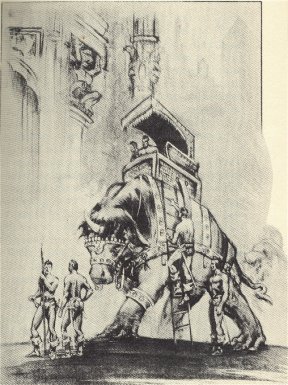 |
Interior Illustration #3 gives another view of the beast, this time with the ladder used to climb up into the howdah. Gantors seem to be as nice to ride as elephants, and the really nice thing is the fact that JCB chose to illustrate them as well as the more ferocious beasts that usually attract artists who want to create dramatic dust jackets. |
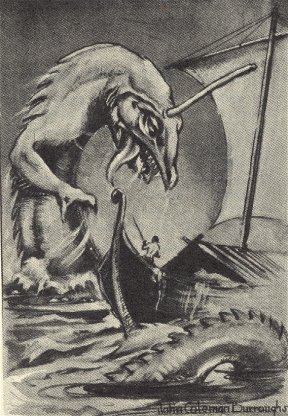 |
JCB does use the dramatic, thousand foot rotik, sea monster for his Frontispiece, “I saw monstrous creatures of the deep.” “It has a wide mouth and huge, protruding eyes between which a smaller eye is perched upon a cylindrical shaft some fifteen feet above its head” (286). Somehow I like his version with the Noah’s ark sail boat as well as the two Frazetta’s versions for the Ace editions. The early Frazetta has the third eye on a stalk, which is for some reason left off the later version. JCB’s rendition has an old story-book quality that is appealing, and a curl of its tail on the other side of the boat gives a greater impression of its great length than the leaping Frazettas. |
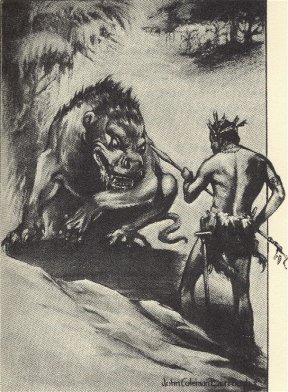 |
Illustration #2 “The beast charged” |
Despite his usual animal depictions -- the gantors of the cover and Illustration #3, the rotik of the frontispiece, and the tharban of Illustration #2 -- all of which could conceivable have been made for other Venus books, JCB did approach the more serious aspect of this novel, that is the parody of Nazi Germany. This more serious intent is shown in two disturbing pieces: Illustrations #4 and #6.
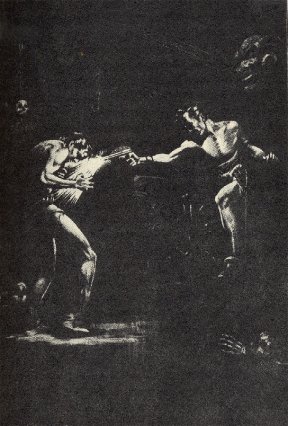 |
Illustration #4 is called “Kord, Jong of Korva, sank lifeless to the floor.” It is a depiction of an assassination, or more specifically, the wanton murder of one man by another. The man with the pistol is Mephis, a thinly veiled Adolph Hitler, head of the Zani Party. He is shown firing point blank into the body of the hereditary ruler of his country. |
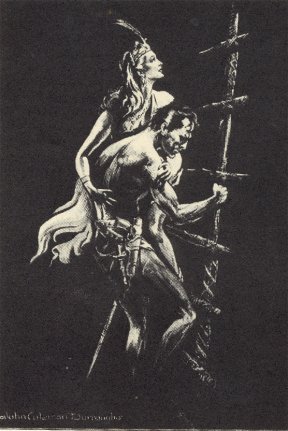 |
Illustration #6 called “In the palace there is a secret shaft” continues this agony in the same dark style. Here a man who appears to be in great pain carries a fairy tale princess down a crude wooden ladder. It is almost a descent from the cross, and like the other picture in this great series of two seems charged with symbolic meaning. One might think of it as a hero descending into hell with the last real princess of story books upon his shoulders. She is still hopeful and young, while the naked man is so burdened with his own grief that he hardly knows what he is carrying. |
JCB accomplished his task of illustrating this book in a masterly fashion, giving us both the quaint Burroughsian beasts and the darker side of a parody, which in retrospect was not funny at all. It was a estimable achievement for which he deserves much praise.
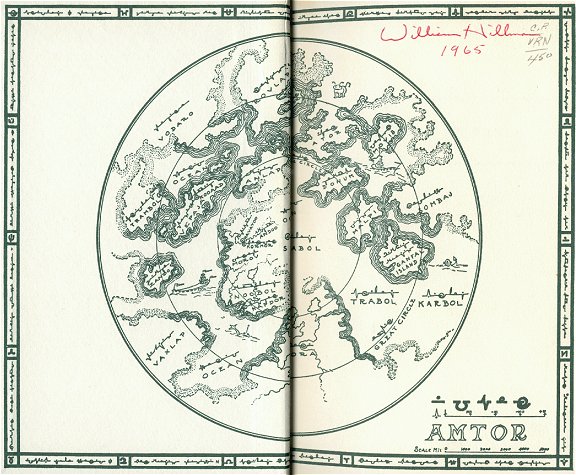
| 4151: I: Mars or Bust | 4152: II: Girl in Garden | 4153: III: Battle Cry | 4154: IV: Gathering Tarel |
| 4155: V: Terror from Sky | 4156: VI: Mutiny at Sea | 4157: VII: Princess of Venus | 4158: VIII: Catastrophe |
| 4159: IX: Land of Noobol | 4160: X: Lost On Venus | 4161: XI: Babes in Woods | 4162: XII: Into Noobolian |
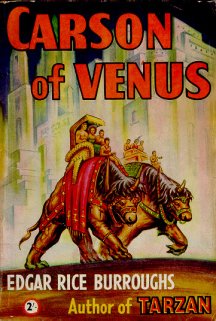
JCB's Art Adapted for a UK Paperback
![]()
![]()
![]()
Volume
0345

BILL
HILLMAN
Visit
our thousands of other sites at:
BILL
amd SUE-ON HILLMAN ECLECTIC STUDIO
ERB
Text, ERB Images and Tarzan® are ©Edgar Rice Burroughs, Inc.-
All Rights Reserved.
All
Original Work ©1996-2006/2017 by Bill Hillman and/or Contributing
Authors/Owners
No
part of this web site may be reproduced without permission from the respective
owners.